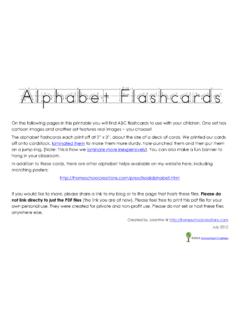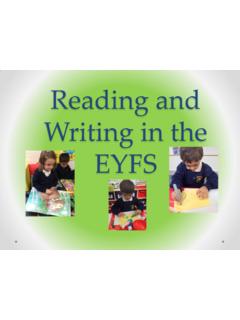Transcription of SECOND WORLD WAR
1 Unit 2: The Home Front ACTIVITY PACK for PRIMARY SCHOOLS SECOND WORLD WAR ONLINE LEARNING RESOURCE for NORTHERN IRELAND Unit 2: The Home Front ACTIVITIES Page iSpy! 3 - 4 Secret Codes 5 - 6 Rationing 7 - 8 Ration Stamp Game 9 Make Do and Mend 10 The Salvage Campaign 11 - 13 Propaganda Posters 14 - 15 Smuggling 16 Story: White Bags in the Moonlight 17 - 18 Red Sails in the Sunset Music Activity 19 Employment 20 Entertainment 21 War Songs 22 Snakes & Ladders 23 - 24 Home Front Word Search 25 Home Front Quiz 26 Glossary 27 Unit 2.
2 The Home Front The British government issued posters to its people to be on alert for enemy spies. Enemy spies disguised themselves as British citizens so they could gather information which might be useful to help Germany win the war. People were encouraged to be careful about who they talked to, in case they were an undercover spy. These posters were a form of government propaganda . Propaganda means information which is spread with the aim of helping a cause, in this case to win the war. Find the spies in the propaganda posters. Circle them when you find them. Can you name the spies? Hint: There are 2 of them. What do you think the term Careless Talk Costs Lives means? Unit 2: The Home Front Unit 2: The Home Front During the war, secret messages were communicated using Morse Code. Morse Code is a system of electronic communication. It uses dots, dashes, and spaces to represent letters, punctuation, and numbers. The symbols are arranged to spell out a message.
3 A machine called a telegraph converts the symbols into electrical signals and sends them across a wire to their destination. The signals are then converted back into the message by the telegraph. The traditional voiced codes are "dit" for the short dot and "dah" for the long dash. Can you voice some letters of the alphabet using dit s and dah s? The Morse Code Alphabet In SPIES & PROPAGANDA, watch the video Wireless Stations. People talk about the Gilnahirk wireless station and listening to secret messages. You can hear morse code in the video listen for the dit s and dah s . Unit 2: The Home Front Morse Code Activity 1 On a piece of paper, write out a short and simple message to your partner in Morse code. Leave a space between the letters. Here is an example: .. __ __ ____ __ ____ __ ____ __ __ HHHH EEEE LLLL LLLL OOOO Morse Code Activity 2 You will need a torch for this activity.
4 With a partner, take turns using the torch to exchange short messages. Use long flashes for dashes and short flashes for dots. Take a short break between letters. When you receive a message, write down the dashes and dots on paper and then decode them! A torch used for Morse Code Message received from my partner My Message in code Message received from my partner Unit 2: The Home Front Define the term rationing . Describe how items were rationed during the SECOND WORLD War. What was the purpose of rationing during the war? What items were rationed? How did people get rationed goods? How did people have to change their eating patterns during the war? List some of the strange things people ate during the war. Explore RATIONING & DIG FOR VICTORY. Look out for answers to the questions below. Unit 2: The Home Front What do these pictures tell us about rationing during the war? Write a caption for these pictures. Unit 2: The Home Front Ration Stamp Game For the next 24 hours you can experience what it was like to live with rationing.
5 As you use an item, mark an X through its coupon. When your coupons have been used up, you may have no more of that item. Stamp Codes: S = 1 Sweet J = 1 Glass or Container of Juice C = 1 Packet of Crisps B = 1 Biscuit T = Half an Hour of Television I = Half an Hour of Internet F = 1 Fizzy Drink M = 1 Use of a Mobile Phone to text or call Unit 2: The Home Front When war broke out it was necessary for everyone, young and old, rich and poor, to live with restrictions. Everyday goods such as clothing and furniture became scarce and unavailable to buy, except on the black market. For ordinary men, women and children it was a case of 'make do and mend'. Thrift and savings became an important part of the war effort. What do you think this girl s coat is made from? Who do you think made it? In Mary Devine s story, Mary remembers how rationing didn't only apply to food. What did Mary use to make a new pair of curtains? Why did she have to use that? In Sheila Hill s story, Sheila remembers how resourceful her mother was.
6 Where did her mother get material to make clothes for Sheila and her brother? Who did Sheila s mother and other women make clothes for? In the video Make Do and Mend, Nell Buckley remembers how clothes were mended to last longer and every scrap of paper was saved. How did people make their clothes go further? Explore MAKE DO AND MEND then answer the questions. Unit 2: The Home Front People in Northern Ireland were encouraged to salvage items that could be recycled to make weapons and other things that could help win the war. To salvage means to save items that might be useful from being thrown away. What items are these children collecting? What did children collect in Sheila s school as part of their salvage campaign? What did children win as prizes for salvaging items? Government posters encouraging people to salvage the most useful items Enter SALVAGING and listen to Sheila Hills' Salvage Campaign, then answer the questions.
7 Unit 2: The Home Front Unit 2: The Home Front Place the items which might have been salvaged into the box. Study the Salvaging Posters for help. Birthday Card Metal Saucepan T-Shirt Old Bread Chicken Bone Banana Skin Newspaper Bicycle Wheel Can you think of another word for Salvaging that is widely used today to mean collecting things which can be reused? Hint: What does the symbol above mean? Are there any items which your family salvages at home? What are they? Investigate what happens to your salvaged items and why people are encouraged to salvage today. SALVAGE COLLECTION BOX Unit 2: The Home Front The government issued posters which were displayed to inform the public about how they could help win the war . Your Task Design a government poster to be posted up around Northern Ireland that encourages people to help win the war in one of the following ways: Mending old items Collecting items for salvaging Being alert for spies Grow own food Joining the Home Guard Joining the Womens Royal Naval Service (WRENS) Getting Started Examine archive propaganda posters.
8 Discuss the images and language used. Think of a catchy slogan for your chosen topic. You may want to use some of these key words or phrases: enemy, ration, coupons, campaign, grow, win the war, make do and mend, Home Guard, government, careless, safety, spies, enemy, talk, salvage, dig for victory, Ulster, munitions, Wrens Explore MAKE DO AND MEND, SALVAGING, SPIES & PROPAGANDA, RATIONING, DIG FOR VICTORY and THE HOME GUARD before starting this activity. The pictures and information in these sections will help you to make your poster . Unit 2: The Home Front Making Your poster 1. Decide whether you want to draw your poster or use computer software Comic Life or Microsoft Word. 2. Decide what pictures you will need for your poster . You can download them from the website, take photos using a digital camera, or draw and scan your own illustrations. 3. If you are using the computer to put together your poster , follow these basic steps: Make a new page Import your pictures into your page and make them the size you want.
9 Add text to your poster . Remember - the more details you add, the better prepared people will be for an air raid! Try out different text styles and effects. Experiment with picture effects and picture borders. Put your name on it! Print your poster and pin it up! Unit 2: The Home Front To many people smuggling became acceptable, even though they knew they were breaking the law. Most smuggled to supply goods to family and friends. At numerous places along the border between Northern Ireland and the Republic of Ireland, people brought goods across the border, meeting Customs Officers along the way. What types of things did people smuggle across the border? Name some of the hiding places people used to bring goods past customs officials. Why did people have to smuggle goods into Northern Ireland? Why do you think goods were more plentiful in Ireland? Explore SMUGGLING and listen to people s experiences of smuggling, then answer the questions. Unit 2: The Home Front Strabane is of course right on the border with the Republic.
10 For Paddy Gillespie, like many others, the temptation to smuggle was too great to resist. You had to do something to make a few bob. Everything was scarce, everything was rationed - petrol coupons, clothing coupons, food coupons - everything. So the opportunity arose that when you found out that a bag of flour was four pound in Strabane and when you took it across to Lifford you got twenty pound for it. That was surely a temptation. I remember the first car years ago that I had was an Austin 7, and I hadn t the money to buy it so I smuggled over three bags of flour and that s where I got the money to buy the Austin 7, my first car you know. So that was the only time in my life I ever actually had any money. I remember an old lorry going down along the River Foyle there to smuggle over hundred-weight bags of flour. On this particular night we had about thirty hundred-weight bags of flour on and it was a lovely moonlight night which is not a good night for smuggling.







